Influence of Post-Consumer Waste Thermoplastic Elastomers Obtained from Used Car Floor Mats on Concrete Properties
Abstract
:1. Introduction
2. Materials and Methods
2.1. Materials
2.2. Methods
3. Results and Discussion
3.1. Characteristics of Post-Consumer Waste
3.2. The Consistency of Concrete Mixes
3.3. The Mechanical Properties of Concretes
3.4. The Other Tested Properties of Concretes
3.5. The Concrete Surface Morphology
4. Conclusions
Author Contributions
Funding
Institutional Review Board Statement
Informed Consent Statement
Data Availability Statement
Acknowledgments
Conflicts of Interest
References
- Directive 2014/955/EU. Journal of the European Union, Brussels. Available online: https://eur-lex.europa.eu/legal-content/EN/TXT/PDF/?uri=CELEX:32014D0955&from=PL (accessed on 1 March 2023).
- Environment 2022, Statistics Poland, Warsaw. 2022. Available online: https://stat.gov.pl (accessed on 1 March 2023).
- Mercante, I.; Alejandrino, C.; Ojeda, J.P.; Chini, J.; Maroto, C.; Fajardo, N. Mortar and concrete composites with recycled plastic: A review. Sci. Technol. Mater. 2018, 30, 69–79. [Google Scholar] [CrossRef]
- Ming, Y.; Chen, P.; Li, L.; Gan, G.; Pan, G. A comprehensive review on the utilization of recycled waste fibers in cement-based composites. Materials 2021, 14, 3643. [Google Scholar] [CrossRef] [PubMed]
- Almeshal, I.; Tayeh, B.A.; Alyousef, R.; Alabduljabbar, H.; Mohamed, A.M.; Alaskar, A. Use of recycled plastic as fine aggregate in cementitious composites: A review. Constr. Build. Mater. 2020, 253, 119146. [Google Scholar] [CrossRef]
- Gu, L.; Ozbakkaloglu, T. Use of recycled plastics in concrete: A critical review. Waste Manag. 2016, 51, 19–42. [Google Scholar] [CrossRef] [PubMed]
- Rashad, A.M. A comprehensive overview about recycling rubber as fine aggregate replacement in traditional cementitious materials. Int. J. Sustain. Built Environ. 2016, 5, 46–82. [Google Scholar] [CrossRef] [Green Version]
- Sharma, R.; Bansal, P.P. Use of different forms of waste plastic in concrete—A review. J. Clean. Prod. 2016, 112, 473–482. [Google Scholar] [CrossRef]
- Ulewicz, M.; Pietrzak, A. Properties and Structure of Concretes Doped with Production Waste of Thermoplastic Elastomers from the Production of Car Floor Mats. Materials 2021, 14, 872. [Google Scholar] [CrossRef]
- Ochi, T.; Okubo, S.; Fukui, K. Development of recycled PET fiber and its application as concrete-reinforcing fiber. Cem. Concr. Compos. 2007, 29, 448–455. [Google Scholar] [CrossRef]
- Choi, Y.W.; Moon, D.J.; Chung, J.S.; Cho, S.K. Effects of waste PET bottlers aggregate on the properties of concrete. Cem. Concr. Res. 2005, 35, 776–781. [Google Scholar] [CrossRef]
- Choi, Y.W.; Moon, D.J.; Kim, Y.J.; Lachemi, M. Characteristics of mortar and concrete containing fine aggregate manufactured from recycled waste polyethylene terephthalate bottles. Constr. Build. Mater. 2009, 23, 2829–2835. [Google Scholar] [CrossRef]
- Nibudey, R.; Nagarnaik, P.; Parbat, D.; Pande, A. Strength and fracture properties of post consumed waste plastic fiber reinforced concrete. Int. J. Civ. Struct. Environ. Infrastruct. Eng. Res. Dev. 2013, 3, 9–16. [Google Scholar]
- Rahmani, E.; Dehestani, M.; Beygi, M.H.A.; Allahyari, H.; Nikbin, I.M. On the mechanical properties of concrete containing waste PET particles. Constr. Build. Mater. 2013, 47, 1302–1308. [Google Scholar] [CrossRef]
- Ferreira, L.; De Brito, J.; Saikia, N. Influence of curing conditions on the mechanical performance of concrete containing recycled plastic aggregate. Constr. Build. Mater. 2012, 36, 196–204. [Google Scholar] [CrossRef]
- Silva, R.; De Brito, J.; Saikia, N. Influence of curing conditions on the durability-related performance of concrete made with selected plastic waste aggregates. Cem. Concr. Compos. 2013, 35, 23–31. [Google Scholar] [CrossRef]
- Saikia, N.; de Brito, J. Waste polyethylene terephthalate as an aggregate in concrete. Mater. Res. 2013, 16, 341–350. [Google Scholar] [CrossRef] [Green Version]
- Bhagat, G.V.; Savoikar, P.P. Durability related properties of cement composites containing thermoplastic aggregates—A review. J. Build. Eng. 2022, 53, 104565. [Google Scholar] [CrossRef]
- Sabaa, B.; Ravindrarajah, R.S. Engineering properties of lightweight concrete containing crushed expanded polystyrene waste. In Proceedings of the Symposium MM: Advances in Materials for Cementitious Composites, Boston, MA, USA, 1–3 December 1997. [Google Scholar]
- Tang, W.; Lo, Y.; Nadeem, A. Mechanical and drying shrinkage properties of structural-graded polystyrene aggregate concrete. Cement Concr. Compos. 2008, 30, 403–409. [Google Scholar] [CrossRef]
- Kan, A.; Demirboğa, R. A novel material for lightweight concrete production. Cement Concr. Compos. 2009, 31, 489–495. [Google Scholar] [CrossRef]
- Herki, A.; Khatib, J.; Negim, E. Lightweight concrete made from waste polystyrene and fly ash. World Appl. Sci. J. 2013, 21, 1356–1360. [Google Scholar]
- Bengin, M.; Herki, A. Absorption Characteristics of Lightweight Concrete Containing Densified Polystyrene. Civ. Eng. J. 2017, 3, 595–609. [Google Scholar]
- Ravindrarajah, R.S. Bearing strength of concrete containing polystyrene aggregate. Durability Build. Mater. Compon. 1999, 8, 505–514. [Google Scholar]
- Babu, K.G.; Babu, D.S. Behaviour of lightweight expanded polystyrene concrete containing silica fume. Cem. Concr. Res. 2003, 33, 755–762. [Google Scholar] [CrossRef]
- Chen, B.; Liu, J. Properties of lightweight expanded polystyrene concrete reinforced with steel fiber. Cem. Concr. Res. 2004, 34, 1259–1263. [Google Scholar] [CrossRef]
- Babu, D.S.; Babu, K.G.; Wee, T. Properties of lightweight expanded polystyrene aggregate concretes containing fly ash. Cem. Concr. Res. 2005, 35, 1218–1223. [Google Scholar] [CrossRef]
- Haghi, A.; Arabani, M.; Ahmadi, H. Applications of expanded polystyrene (EPS) beads and polyamide-66 in civil engineering, Part One: Lightweight polymeric concrete. Compos. Interfaces 2006, 13, 441–450. [Google Scholar] [CrossRef]
- Babu, D.S.; Babu, K.G.; Tiong-Huan, W. Effect of polystyrene aggregate size on strength and moisture migration characteristics of lightweight concrete. Cem. Concr. Compos. 2006, 28, 520–527. [Google Scholar] [CrossRef]
- Madandoust, R.; Ranjbar, M.M.; Mousavi, S.Y. An investigation on the fresh properties of self-compacted lightweight concrete containing expanded polystyrene. Constr. Build. Mater. 2011, 25, 3721–3731. [Google Scholar] [CrossRef]
- Xu, Y.; Jiang, L.; Xu, J.; Li, Y. Mechanical properties of expanded polystyrene lightweight aggregate concrete and brick. Constr. Build. Mater. 2012, 27, 32–38. [Google Scholar] [CrossRef]
- Chaudhary, M.; Srivastava, V.; Agarwal, V. Effect of waste low density polyethylene on mechanical properties of concrete. J. Acad. Ind. Res. 2014, 3, 123. [Google Scholar]
- Martínez-Barrera, G.; Vigueras-Santiago, E.; Hernández-López, S.; Brostow, W.; Menchaca-Campos, C. Me-chanical improvement of concrete by irradiated polypropylene fibers. Polym. Eng. Sci. 2005, 45, 1426–1431. [Google Scholar] [CrossRef]
- Abdelmoti, H.; Mustafa, A.M. Use of Polypropylene Waste Plastic Pellets as Partial Replacement for Fine Aggregate in Concrete. Univ. Khartoum Eng. J. 2019, 9, 37–43. [Google Scholar]
- Wang, Y.; Wu, H.; Li, V.C. Concrete reinforcement with recycled fibers. J. Mater. Civ. Eng. 2000, 12, 314–319. [Google Scholar] [CrossRef]
- Kojnoková, T.; Markovičová, L.; Nový, F. The changes of LD-PE films after exposure in different media. Prod. Eng. Arch. 2020, 26, 185–189. [Google Scholar] [CrossRef]
- Kakooei, S.; Akil, H.M.; Jamshidi, M.; Rouhi, J. The effects of polypropylene fibers on the properties of reinforced concrete structures. Constr. Build. Mater. 2012, 27, 73–77. [Google Scholar] [CrossRef]
- Sivakumar, A.; Santhanam, M. A quantitative study on the plastic shrinkage cracking in high strength hybrid fibre reinforced concrete. Cem. Concr. Compos. 2007, 29, 575–581. [Google Scholar] [CrossRef]
- Pietrzak, A.; Ulewicz, M. The impact of the length of polypropylene fibers on selected properties of concrete. Acta Sci. Pol. Arch. Bud. 2019, 18, 21–25. [Google Scholar] [CrossRef]
- Sofi, A. Effect of waste tyre rubber on mechanical and durability properties of concrete—A review. Ain Shams Eng. J. 2018, 9, 2691–2700. [Google Scholar] [CrossRef]
- Balaha, M.M.; Badawy, A.A.M.; Hashish, M. Effect of using ground tire rubber as fine aggregate on the behaviour of concrete mixes. Indian J. Eng. Mater. Sci. 2007, 14, 427–435. [Google Scholar]
- Albano, C.; Camacho, N.; Reyes, J.; Feliu, J.L.; Hernández, M. Influence of scrap rubber to Portland I concrete composites: Destructive and non-destructive testing. Compos. Struct. 2005, 71, 439–446. [Google Scholar] [CrossRef]
- Bravo, M.; de Brito, J. Concrete made with used tyre aggregate: Durability-related performance. J. Clean. Prod. 2012, 25, 42–50. [Google Scholar] [CrossRef]
- Taha, M.M.R.; El-Dieb, A.S.; El-Wahab, M.A.A.; Abdel-Hameed, M.E. Mechanical, fracture, and microstructural investigations of rubber concrete. J. Mater. Civ. Eng. 2008, 20, 640–649. [Google Scholar] [CrossRef]
- Lavagna, L.; Nisticò, R.; Sarasso, M.; Pavese, M. An Analytical Mini-review on the compression strength of rubberized concrete as a function of the amount of recycled tires crumb rubber. Materials 2020, 13, 1234. [Google Scholar] [CrossRef] [PubMed] [Green Version]
- Guelmine, L. The freeze-thaw durability of concrete containing the rubber aggregate of tirewaste. Res. Eng. Struct. Mater. 2022, 8, 253–264. [Google Scholar]
- Gesoğlu, M.; Güneyisi, E. Strength development and chloride penetration in rubberized concretes with and without silica fume. Mater. Struct. 2007, 40, 953–964. [Google Scholar] [CrossRef]
- Onuaguluchi, O.; Panesar, D.K. Hardened properties of concrete mixtures containing pre-coated crumb rubber and silica fume. J. Clean. Prod. 2014, 82, 125–131. [Google Scholar] [CrossRef]
- Pelisser, F.; Zavarise, N.; Longo, T.A.; Bernardin, A.M. Concrete made with recycled tire rubber: Effect of alkaline activation and silica fume addition. J. Clean. Prod. 2011, 19, 757–763. [Google Scholar] [CrossRef]
- Haghighatnejad, N.; Mousavi, S.Y.; Khaleghi, S.J.; Tabarsa, A.T.; Yousefi, S. Properties of recycled PVC aggregate concrete under different curing conditions. Constr. Build. Mater. 2016, 126, 943–950. [Google Scholar] [CrossRef]
- Najjar, A.K.; Bashaand, E.A.; Milad, M.B.K. Rigid polyvinyl chloride waste for partial replacement of natural coarse aggregate in concrete mixture. Int. J. Chem. Environ. Eng. 2013, 4, 399–403. [Google Scholar]
- Kou, S.C.; Lee, G.; Poon, C.S.; Lai, W.L. Properties of lightweight aggregate concrete prepared with PVC granules derived from scraped PVC pipes. Waste Manag. 2009, 29, 621–628. [Google Scholar] [CrossRef]
- Senhadji, Y.; Escadeillas, G.; Benosman, A.S.; Mouli, M.; Khelafi, H.; Kaci, S.O. Effect of incorporating PVC waste as aggregate on the physical, mechanical, and chloride ion penetration behavior of concrete. J. Adhes. Sci. Technol. 2015, 29, 625–640. [Google Scholar] [CrossRef]
- Mounanga, P.; Gbongbon, W.; Poullain, P.; Turcry, P. Proportioning and characterization of light weight concrete mixtures made with rigid polyurethane foam wastes. Cem. Concr. Compos. 2008, 30, 806–814. [Google Scholar] [CrossRef] [Green Version]
- Pietrzak, A.; Ulewicz, M. The influence of post-consumer car mats waste on selected concrete parameters. E3S Web Conf. 2018, 49, 00082. [Google Scholar] [CrossRef] [Green Version]
- Garcia, P.S.; de Sousa, F.D.B.; de Lima, J.A.; Cruz, S.A.; Scuracchio, C.H. Devulcanization of ground tire rubber: Physical and chemical changes after different microwave exposure times. Polym. Lett. 2015, 9, 1015–1026. [Google Scholar] [CrossRef]
- Mora-Rodríguez, G.K.; Hernández Carrillo, C.G.; Pineda-Triana, Y. Compositional, thermal and morphological characterization of recycled and modified elastomers for inclusion in commercial cement mixtures. J. Phys. Conf. Ser. 2019, 1386, 012064. [Google Scholar] [CrossRef]
- Nabajyoti Saikia, N.; de Brito, J. Use of plastic waste as aggregate in cement mortar and concreto preparation: A review. Constr. Build. Mater. 2012, 34, 385–401. [Google Scholar] [CrossRef]
- Albano, C.; Camacho, N.; Hernandez, M.; Matheus, A.; Gutierrez, A. Influence of content and particle size of pet waste bottles on concrete behaviour at different w/c ratios. Waste Manag. 2009, 29, 2707–2716. [Google Scholar] [CrossRef]
- Saikia, N.; de Brito, J. Mechanical properties and abrasion behaviour of concreto containing shredded pet waste bottle aggregate as a partial substitution of natural aggregate. Constr. Build. Mater. 2014, 52, 236–244. [Google Scholar] [CrossRef]
- Hannawi, K.; Kamali-Bernard, S.; Prince, W. Physical and mechanical properties of mortars containing PET and PC waste aggregates. Waste Manag. 2010, 30, 2312–2320. [Google Scholar] [CrossRef]
- Jura, J.; Ulewicz, M. Assessment of the Possibility of Using Fly Ash from Biomass Combustion for Concrete. Materials 2021, 14, 6708. [Google Scholar] [CrossRef]
- Olofinnade, O.M.; Ede, A.N.; Ndambuki, J.M.; Ngene, B.U.; Akinwumi, I.I.; Ofuyatan, O. Strength and microstructure of eco-concreteproduced using waste glass as partial andcomplete replacement for sand. Cogent Eng. 2018, 5, 1483860. [Google Scholar] [CrossRef]
- Dobiszewska, M.; Beycioğlu, A. Physical Properties and Microstructure of Concrete with Waste Basalt Powder Addition. Materials 2020, 13, 3503. [Google Scholar] [CrossRef] [PubMed]
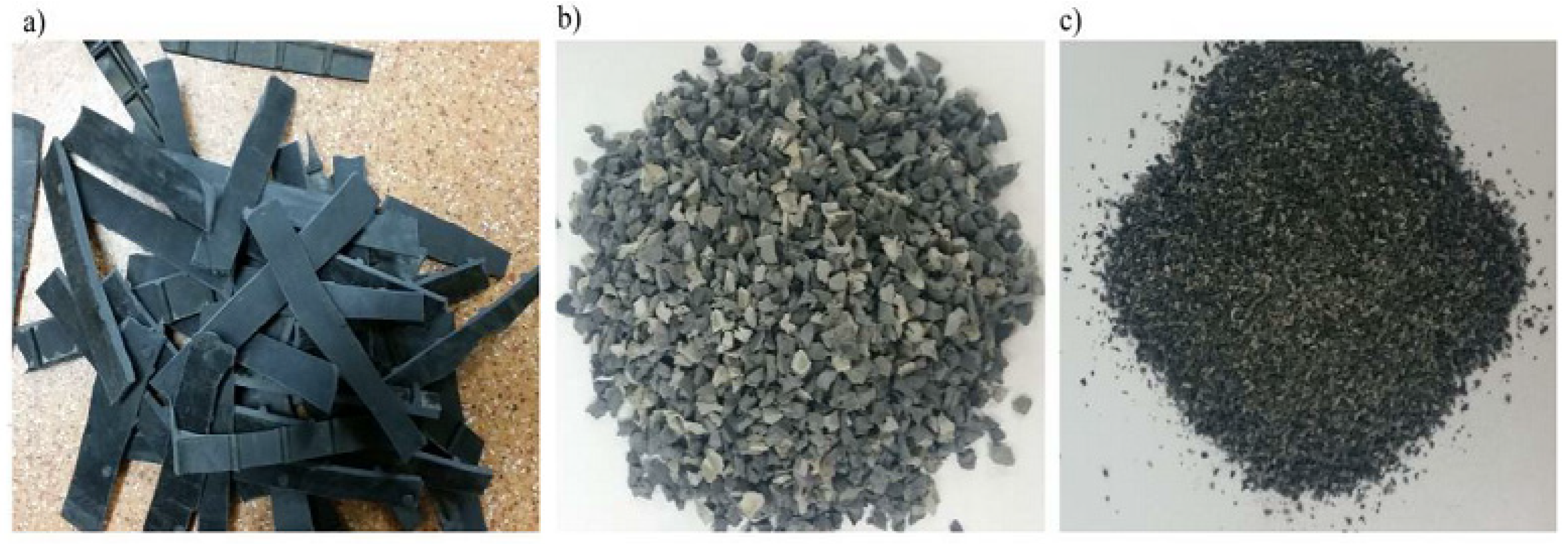
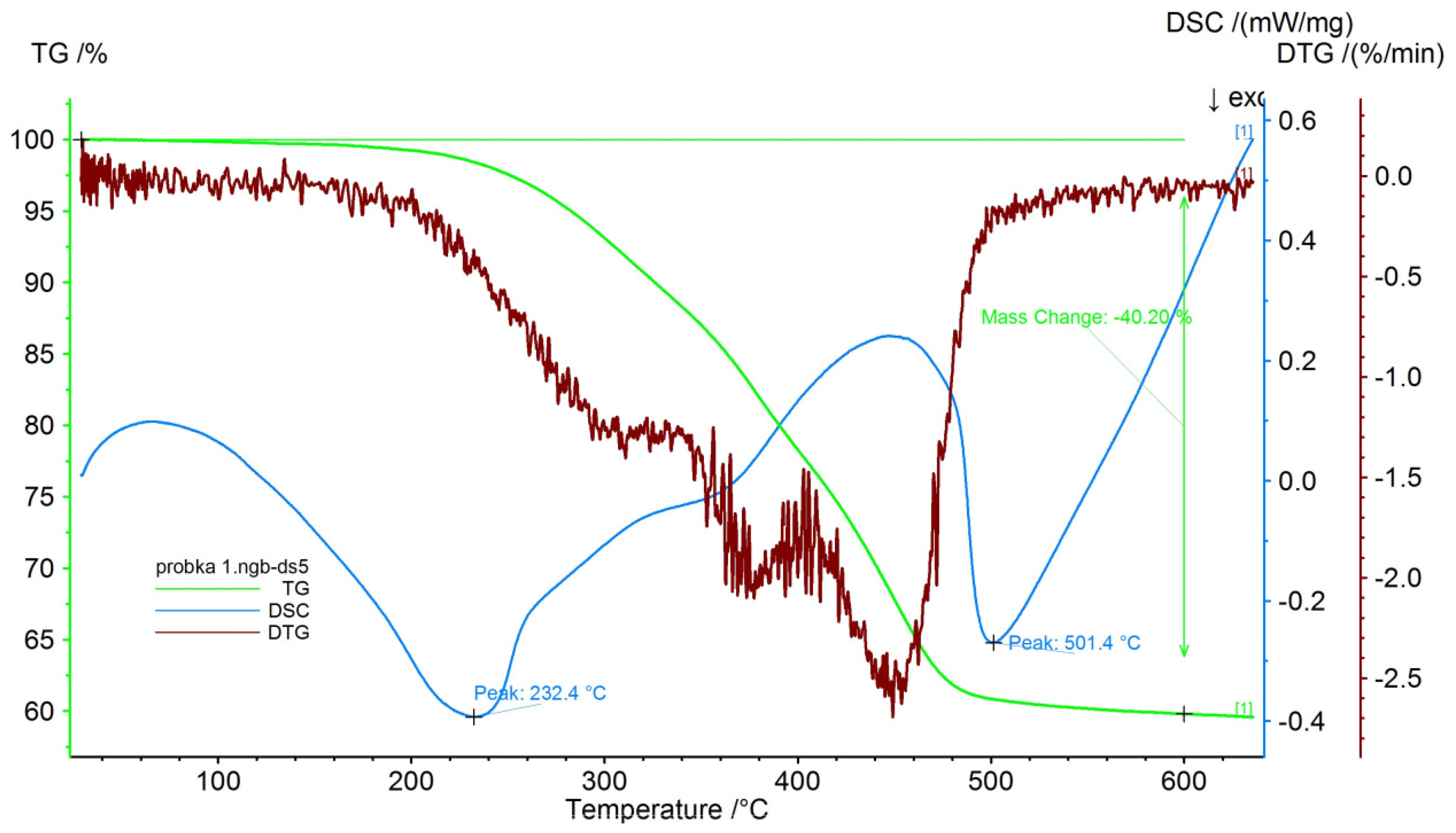
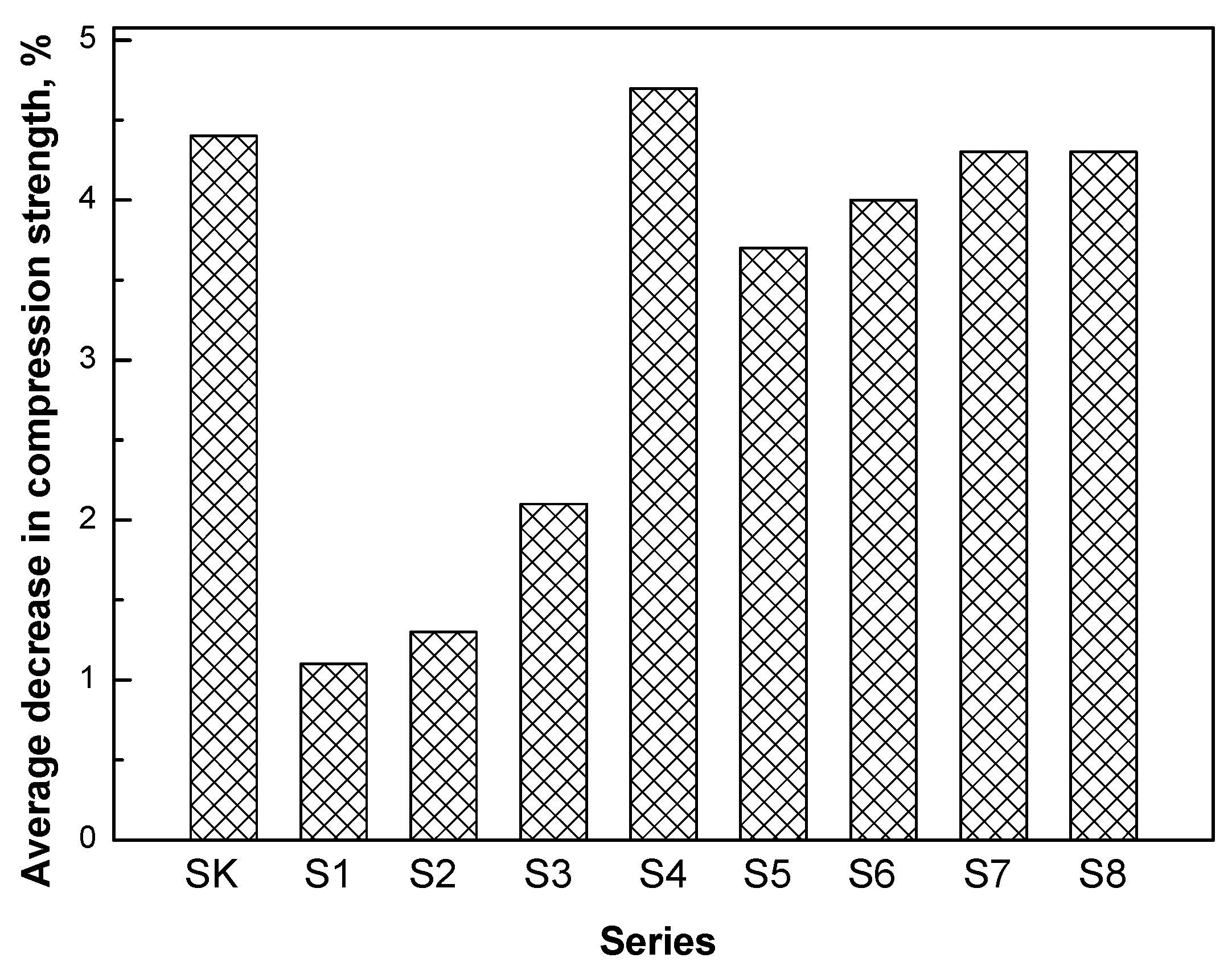
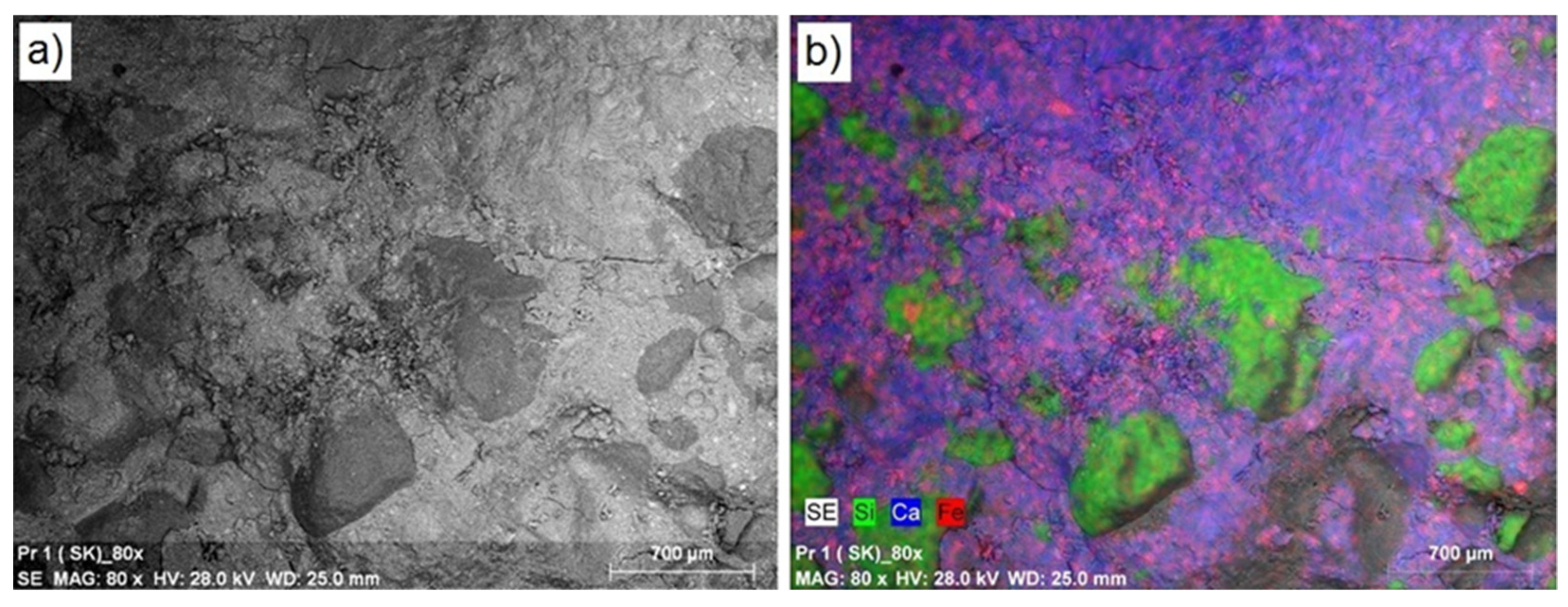
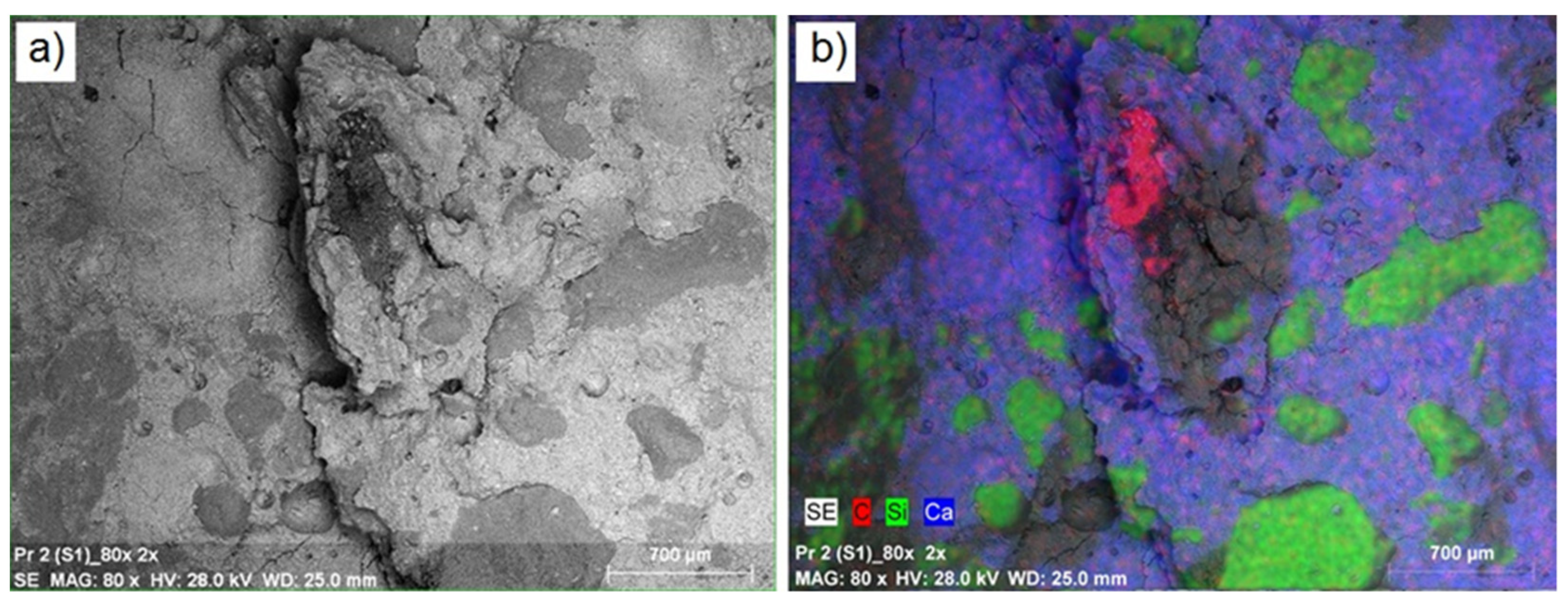
| Composition | Units | Series | ||||||||
|---|---|---|---|---|---|---|---|---|---|---|
| SK | S1 | S2 | S3 | S4 | S5 | S6 | S7 | S8 | ||
| Sand | kg/m3 | 463.70 | 443.6 | 423.6 | 403.5 | 384.4 | 463.7 | 463.7 | 463.7 | 463.7 |
| Gravel 8–16 mm | kg/m3 | 776.20 | 776.2 | 776.2 | 776.2 | 776.2 | 776.2 | 776.2 | 776.2 | 776.2 |
| Gravel 2–8 mm | kg/m3 | 635.10 | 635.1 | 635.1 | 635.1 | 635.1 | 615.0 | 594.9 | 574.9 | 554.8 |
| Post-consumer waste | kg/m3 | - | 9.31 | 18.63 | 27.94 | 37.25 | 9.310 | 18.63 | 27.94 | 37.25 |
| Elemental Composition (% (m/m)) | |||||||||||
|---|---|---|---|---|---|---|---|---|---|---|---|
| Ca | Si | Al | Zn | S | Ti | Ba | Fe | K | Sr | C | Other |
| 5.37 | 1.36 | 0.93 | 0.60 | 0.37 | 0.09 | 0.10 | 0.05 | 0.06 | 0.01 | 78.10 | 12.92 |
| Series | Consistence (mm)/Class | Air Content (%) |
|---|---|---|
| SK | 70/S2 | 3.50 |
| S1 | 70/S2 | 4.30 |
| S2 | 50/S2 | 4.20 |
| S3 | 50/S2 | 4.15 |
| S4 | 50/S2 | 3.90 |
| S5 | 65/S2 | 3.90 |
| S6 | 60/S2 | 4.20 |
| S7 | 70/S2 | 4.60 |
| S8 | 50/S2 | 4.00 |
| Series | Compression Strength (MPa) | Resistance Class | ||
|---|---|---|---|---|
| After 7 Days | After 28 Days | After 56 Days | ||
| SK | 46.6 | 57.0 | 61.9 | C40/50 |
| S1 | 46.3 | 57.0 | 62.0 | C40/50 |
| S2 | 41.1 | 50.1 | 56.2 | C35/45 |
| S3 | 40.7 | 48.4 | 51.0 | C30/37 |
| S4 | 40.0 | 47.4 | 50.8 | C30/37 |
| S5 | 46.2 | 57.2 | 62.1 | C40/50 |
| S6 | 43.9 | 50.7 | 56.8 | C35/45 |
| S7 | 42.0 | 48.5 | 54.9 | C30/37 |
| S8 | 40.0 | 46.9 | 54.3 | C30/37 |
| Series | Flexural Strength (MPa) | Splitting Tensile Strength (MPa) |
|---|---|---|
| SK | 3.59 | 3.78 |
| S1 | 3.38 | 4.15 |
| S2 | 3.36 | 3.8 |
| S3 | 3.36 | 3.25 |
| S4 | 3.34 | 3.06 |
| S5 | 3.85 | 4.19 |
| S6 | 3.71 | 3.88 |
| S7 | 3.42 | 3.61 |
| S8 | 3.38 | 3.58 |
| Series | Water Absorbability (%) | Density (kg/m3) | Water Penetration (mm) | Abrasion Strength (cm2/50 cm2) |
|---|---|---|---|---|
| SK | 5.4 | 2271 | 65 | 7.4 |
| S1 | 5.5 | 2245 | 55 | 6.5 |
| S2 | 5.6 | 2233 | 63 | 6.7 |
| S3 | 5.5 | 2220 | 67 | 6.9 |
| S4 | 4.9 | 2219 | 70 | 7.3 |
| S5 | 5.6 | 2227 | 60 | 6.9 |
| S6 | 5.5 | 2222 | 60 | 6.9 |
| S7 | 5.6 | 2212 | 65 | 7.3 |
| S8 | 5.2 | 2210 | 68 | 7.5 |
Disclaimer/Publisher’s Note: The statements, opinions and data contained in all publications are solely those of the individual author(s) and contributor(s) and not of MDPI and/or the editor(s). MDPI and/or the editor(s) disclaim responsibility for any injury to people or property resulting from any ideas, methods, instructions or products referred to in the content. |
© 2023 by the authors. Licensee MDPI, Basel, Switzerland. This article is an open access article distributed under the terms and conditions of the Creative Commons Attribution (CC BY) license (https://creativecommons.org/licenses/by/4.0/).
Share and Cite
Pietrzak, A.; Ulewicz, M. Influence of Post-Consumer Waste Thermoplastic Elastomers Obtained from Used Car Floor Mats on Concrete Properties. Materials 2023, 16, 2231. https://doi.org/10.3390/ma16062231
Pietrzak A, Ulewicz M. Influence of Post-Consumer Waste Thermoplastic Elastomers Obtained from Used Car Floor Mats on Concrete Properties. Materials. 2023; 16(6):2231. https://doi.org/10.3390/ma16062231
Chicago/Turabian StylePietrzak, Alina, and Malgorzata Ulewicz. 2023. "Influence of Post-Consumer Waste Thermoplastic Elastomers Obtained from Used Car Floor Mats on Concrete Properties" Materials 16, no. 6: 2231. https://doi.org/10.3390/ma16062231
APA StylePietrzak, A., & Ulewicz, M. (2023). Influence of Post-Consumer Waste Thermoplastic Elastomers Obtained from Used Car Floor Mats on Concrete Properties. Materials, 16(6), 2231. https://doi.org/10.3390/ma16062231







